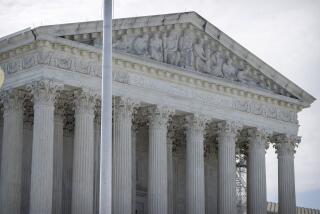U.S. court upholds Trump’s rule involving abortion cases
- Share via
A federal appeals court, divided along party lines, decided Monday to uphold a new Trump administration rule denying family planning grants to clinics that make referrals for abortion.
On a 7-4 vote, an en banc panel of the U.S. 9th Circuit Court of Appeals upheld the 2019 rule, saying the family planning program was limited by similar abortion-related restrictions in the past, and the U.S. Supreme Court upheld them.
The decision overturned injunctions issued by different judges in three Western states, including California.
Monday’s ruling was a sign of just how much the 9th Circuit has changed since President Trump replaced 10 judges, more than one third of the active jurists. Randomly drawn panels that decide challenges to Trump policies are now much more likely to have Republican majorities.
“The Supreme Court has long recognized that abortion need not be treated the same as other medical procedures,” Judge Sandra S. Ikuta, appointed by President George W. Bush, wrote for the majority.
The 9th Circuit , she said, should not “second-guess” how the Trump administration analyzed the risks and benefits of the rule.
All the judges who sided with Trump were appointed by Republicans, including two named by Trump. The dissenters were appointed by Democrats.
Family planning organizations, the American Medical Assn., 22 states — including California — and the District of Columbia challenged the Trump rule.
It established new requirements for funds distributed under Title X, a 1970 federal law intended to help poor women and those in isolated, rural settings obtain family planning services. In addition to banning abortion referrals, the rule requires recipients of the funds to refer pregnant women for prenatal care, even if the patients want abortions. Recipients also must encourage patients to discuss their situations with their families and to tell single women about the benefits of abstinence.
More than 4 million people in the U.S., 1 million of them in California, rely on Title X funding to obtain contraception, cervical and breast cancer screenings, and testing and treatment for sexually transmitted diseases. Planned Parenthood determined it could not comply with the new rule, losing $60 million a year in federal funds as a result.
The dissenting judges said the rule gagged healthcare providers from fully counseling pregnant women about their options and required them instead to steer women toward childbirth. The majority, the dissent said, upheld a “gross overreach” by the administration and put “its own policy preferences before the law.”
“Women and their families will suffer for it,” Judge Richard Paez, a Clinton appointee, wrote for the dissenters.
The 9th Circuit majority “would return us to an older world, one in which a government bureaucrat could restrict a medical professional from informing a patient of the full range of healthcare options available to her,” Paez wrote.
Julie Rabinovitz, president and CEO of Essential Access Health, called the ruling devastating for millions of low-income patients who rely on the federal funds for quality sexual and reproductive healthcare.
In California, she said, the rule already has triggered a 40% cut in the number of in patients served by the program, with rural and minority communities affected disproportionately.
“The federal government has no business getting in the way of a woman’s ability to make personal decisions about her health,” said Rabinovitz, whose nonprofit group administers the federal family planning program in California.
A portion of the rule that will prohibit federal recipients from sharing office space with abortion providers could lead to further cutbacks when it takes effect next month, she said.
After a three-judge panel of Republican appointees ruled in favor of the rule last June, another 9th Circuit judge called internally for a larger, en banc panel to reconsider the case. A majority of active judges agreed, and program supporters expressed relief.
A random drawing of names for the 11-judge en banc panel then produced a Republican majority, which quickly decided on a divided vote to allow the rule to go forward.
Opponents of the new rule could seek review by the U.S. Supreme Court, which has a conservative majority that has largely sided with Trump.
More to Read
Sign up for Essential California
The most important California stories and recommendations in your inbox every morning.
You may occasionally receive promotional content from the Los Angeles Times.











